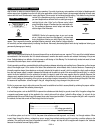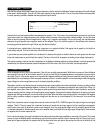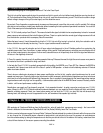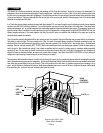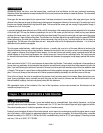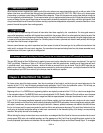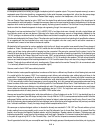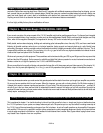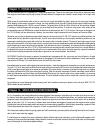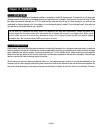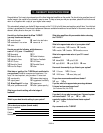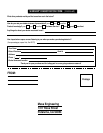
PAGE 21
The most common failure in a tube amp are ... tubes, you guessed right. There are two main types of tube failure: shorts and noise.
Both large and small tubes may fall prey to either of these problems, but diagnosis and remedy is usually simple. Let’s begin with
noise:
Often caused by contamination within a tube, a noisy tube can usually be identified by lightly tapping on the outer glass envelope.
When tapping a tube causes the noise to change, you have probably found the culprit. Hearing some residual noise through the
speakers while tapping on the 12AX7s is normal, however. The power tubes, EL84s and 6V6s, should be all but quiet when tapped.
If crackling or hissing changes with the tapping, you have likely found the problem. To confirm a noisy power tube, simply put the
corresponding channel in WARM mode, remove the tube from its socket and turn the TIGRIS back on. It will cause no damage to run
the TIGRIS briefly with one tube missing. However, you may notice a slight background hum as the push-pull balance offsets.
Whenever you are trying to diagnose a suspect tube, keep your other hand on the A.C. ON / OFF switch to shut off the amplifier in the
unlikely event that you provoke a major tube short. If you’re unsure about whether you have properly identified a problem tube, we
recommend substituting the suspect with a tube from the same location in the other channel. The second, less benign cause for tube
failure is the severe short. In the worst case scenario, a major arcing short occurs between the plate and cathode with visible lightning
inside the glass and a major noise through the speaker. If you witness such a short, immediately turn the amp off while unplugging the
A.C. power cord from the rear of the TIGRIS. By this time the rear-mounted fuse will probably have blown but the current drawn by
the shorted tube can be so excessive that pulling the cord is recommended. Such a short is usually caused by a physical breakdown
inside the tube including contaminate coming loose or physical or near contact between the elements.
NO SOUND: Check that the amp is in operate, the selected input corresponds with the source you are trying to listen to, all cable
connections are proper, and the Headphone selector is disengaged. If the trouble occurs with a subwoofer or a multi room amplifier
connected to the Preamp Out, check that the Level Set control isn’t fully closed.
Intermittent sound/no sound could indicate a bad cable termination - check the interconnects attached to your currently active source.
Turn the TIGRIS off, disconnect the RCAs from the input jacks and unscrew the RCA cover to visually inspect the internal solder joint
of the hot and ground conductors to the center pin and sleeve. If the cover doesn’t unscrew or is encased in heat shrink, try wiggling
the cables right behind the RCA jacks while signal is playing. Often this physical movement will make intermittent contact when a
solder joint has broken and thus indicate a faulty termination.Should only one channel suffer from a muted condition, try reversing
the input leads to see whether the muted channel follows. This could indicate a broken cable or trouble with a channel of your source
component.
For conditions you cannot adequately trouble-shoot yourself, don’t hesitate to contact your retailer or call us direct at (USA) 707-778-
9505 to obtain personal assistance.
At Mesa Engineering, we strongly believe that musical enjoyment from listening to recorded music is a matter of the heart and soul of
the listener, while specs appeal primarily to the mind. With the advent of ultra-sophisticated military- and medical-grade measuring
equipment, specs are obtainable that look mightily impressive on paper but bear little correlation to the real world, such as distortion
specs of less than 1/2%. It is very easy to obsess about the theoretical advantages of components that measure better, entirely
forgetting that many of these measurements are beyond our human hearing capabilities. Unfortunately, assembling a system of Class
A rated components with state-of-the-art specs is, in itself, no guarantee for first-rate performance.
This is because, besides matters of synergy, specs don’t tell the whole story, and many factors influencing final results aren’t measur-
able, or don’t mean what they suggest.
It is well-known, for example, that vacuum tubes have higher distortion specs than transistors, and that electrostatic speakers don’t
measure as flat as many dynamic designs. Many listeners, however, much prefer the sound of tubes to solid state, and the transpar-
ency of electrostats to conventional speaker designs.
Chapter 11 -TROUBLE SHOOTING:
Chapter 12 - SPECS VERSUS PERFORMANCE :



